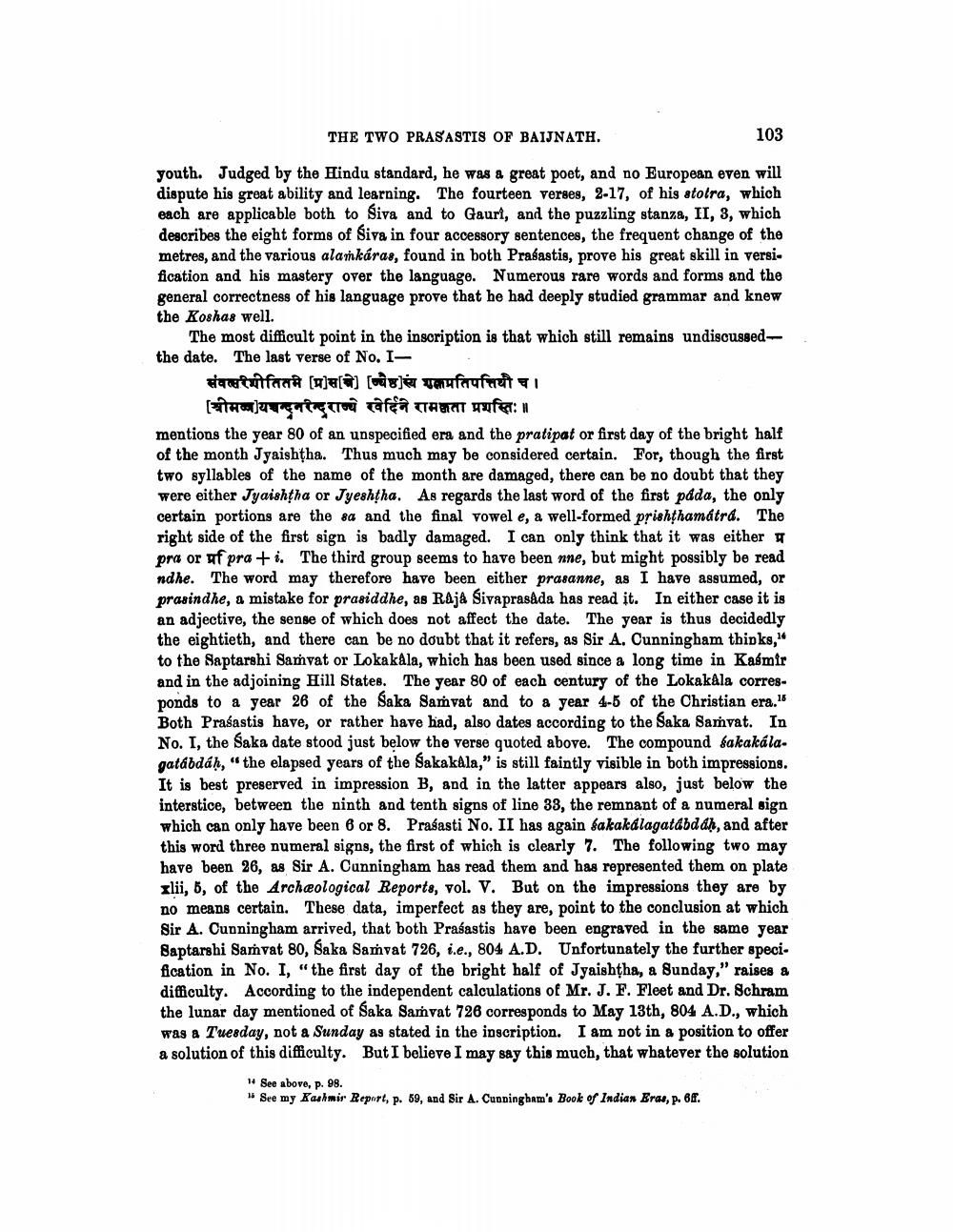________________
THE TWO PRASASTIS OF BAIJNATH.
103
youth. Judged by the Hindu standard, he was a great poet, and no European even will dispute his great ability and learning. The fourteen verses, 2-17, of his atotra, which each are applicable both to Siva and to Gauri, and the puzzling stanza, II, 3, which describes the eight forms of Siva in four accessory sentences, the frequent change of the metres, and the various alankáras, found in both Prasastis, prove his great skill in versification and his mastery over the language. Numerous rare words and forms and the general correctness of his language prove that he had deeply studied grammar and knew the Koshas well.
The most difficult point in the inscription is that which still remains undiscussed the date. The last verse of No. I
संवत्सरणीतितम [प्रसाचे ज्येष्ठ]स्य सकप्रतिपत्तियौ च ।
[श्रीमजयचन्दनरेन्दराज्ये वेर्दिने रामकता प्रशस्तिः । mentions the year 80 of an unspecified era and the pratipat or first day of the bright half of the month Jyaishtha. Thus much may be considered certain. For, though the first two syllables of the name of the month are damaged, there can be no doubt that they were either Jyaishtha or Jyeshtha. As regards the last word of the first pada, the only certain portions are the sa and the final vowel e, a well-formed prishthamátra. The right side of the first sign is badly damaged. I can only think that it was either pra or af pra + i. The third group seems to have been nne, but might possibly be read ndhe. The word may therefore have been either prasanne, as I have assumed, or prasindhe, a mistake for prasiddhe, as Raja Sivaprasada has read it. In either case it is an adjective, the sense of which does not affect the date. The year is thus decidedly the eightieth, and there can be no doubt that it refers, as Sir A. Cunningham thinks, to the Saptarshi Samvat or Lokakala, which has been used since a long time in Kasmir and in the adjoining Hill States. The year 80 of each century of the Lokakala corresponds to a year 26 of the Saka Samvat and to a year 4-5 of the Christian era.16 Both Prasastis have, or rather have had, also dates according to the Saka Samvat. In No. I, the Saka date stood just below the verse quoted above. The compound bakakála. gatábdáh," the elapsed years of the Sakakala," is still faintly visible in both impressions. It is best preserved in impression B, and in the latter appears also, just below the interstice, between the ninth and tenth signs of line 38, the remnant of a numeral sign which can only have been 6 or 8. Prasasti No. II has again fakakalagat&bd dh, and after this word three numeral signs, the first of which is clearly 7. The following two may have been 26, as Sir A. Cunningham has read them and has represented them on plate xlii, 6, of the Archeological Reports, vol. V. But on the impressions they are by no means certain. These data, imperfect as they are, point to the conclusion at which Sir A. Cunningham arrived, that both Prasastis have been engraved in the same year Baptarshi Samvat 80, Saka Samvat 726, i.e., 804 A.D. Unfortunately the further speci. fication in No. I," the first day of the bright half of Jyaishtha, a Sunday," raises a difficulty. According to the independent calculations of Mr. J. F. Fleet and Dr. Schram the lunar day mentioned of Saka Samvat 726 corresponds to May 13th, 804 A.D., which was a Tuesday, not a Sunday as stated in the inscription. I am not in a position to offer a solution of this difficulty. But I believe I may say this much, that whatever the solution
** See above, p. 98. " See my Kashmir Report, p. 59, and Sir A. Cunningham's Book of Indian Eras, p. 64.




